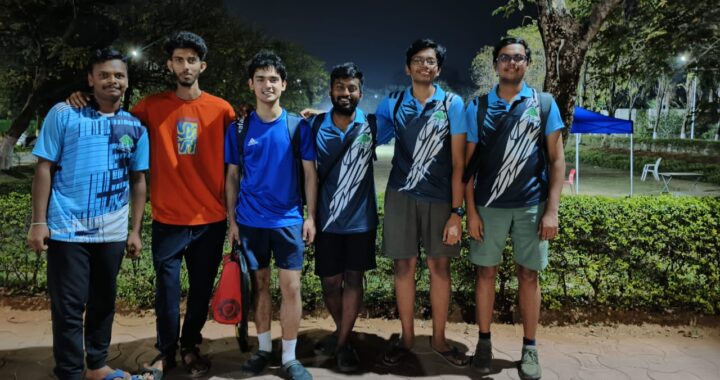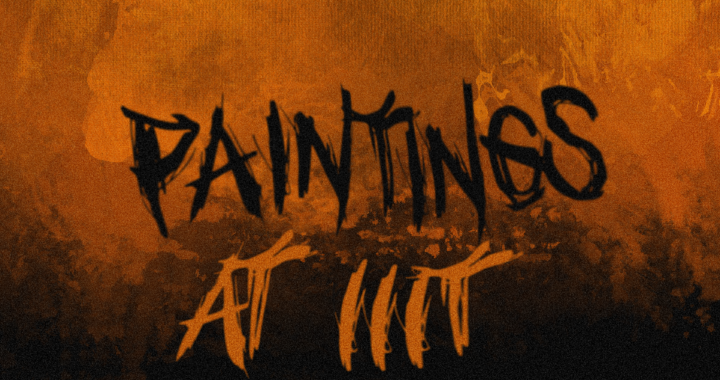What if …? Considerations For a IIIT Post Pandemic

What if we could P* everything? And Other Considerations
What if there were recorded and live-streamed lectures?
What if there was no attendance?
What if IIIT had OpenCourseWare?
What if there was another crisis?
Once the current situation boils over, there is likely going to be a push worldwide to restore the status quo. Nothing could be worse for the world than a rushed attempt to return to the past, without acknowledging the difficulties and hurdles that entire communities braved through to date. With the pandemic came a string of changes that were forced on all, a complete shift in our perception of how various activities could be carried out. We became tuned to the need for social interaction, realized what meetings truly could’ve just been messages, and above all broke the monotony of our regular life. The same monotony that has defined how we carry out the day to day has also suppressed critique over why our routines exist to begin with. The hidden silver lining, for those who intend to emerge from this, is that the COVID pandemic has offered several the room to analyze and rethink their activities. For us at IIIT, the pandemic turned our entire academic system upside down in nearly every sense. Examinations were cancelled for all, attendance was ignored, grading was relaxed extremely with even Pass/Fail as an option! A student in 2019 would have considered these to be unimaginable under standard circumstances. Here, we speculate about the future for IIIT post-pandemic, drawing from the lessons that this academic year has taught us.
What if we could P* everything? And Other Considerations
The New Grading Scheme
The COVID situation required the institute to make a decision about the way the remainder of the semester was to be conducted, and they had to make the decision quickly. The students were pleasantly surprised to see that there was a change in the grading scheme. The new scheme basically entailed two major changes:
- The grades to be given were just A,B,C and W in some courses, which means the students could withdraw the grade instead of it showing an F.
- Students had the choice to P* certain courses, which meant that the course would not count towards GPA considering the extenuating circumstances.
This change in grading scheme begs the question: Can this scheme be a viable alternative for future semesters? There are two considerations here – reducing the number of letter grades to just three (A, B, C) and giving students an option to mask their grade in any course.
The ABC system
This is quite an interesting consideration simply because it is extremely advantageous to students. All minus grades will mostly get bumped up, boosting one’s GPA. Students would have likely been satisfied with such a system this semester considering the grades that they’ve gotten but this semester’s experiment is marred by the lax grading curve due to the pandemic. In a more general scenario, it is possible that the cutoffs for A be higher than the regular A- depending on the professor. But, even if this was a good solution for students, it is impractical for other reasons.
Just three letter grades is barely a precise depiction of student calibre since an excellent performer and a good performer have virtually no differentiation. This difference is a generally good measure for external recruiters and professors to gauge a students performance. Hence, it’s unlikely that this system continues in the long run.
P* ing courses
It’s immediately apparent that giving students an option to P* any course could result in a very masked transcript. Additionally, the GPA would likely be inflated for most due to masking. It is the existence of GPA that fundamentally makes P*ing unlikely.
At Brown University, students have the option to take a course with a Satisfactory/No Credit grading initially. Here, students are required to choose between a graded scheme and the ungraded version before course completion. The critical difference between IIIT and Brown is that Brown does not calculate GPA! Without a GPA, external recruiters are forced to look at transcripts or self-evaluations from students to gauge their performance. Hence, GPA inflation is hardly a concern. Interestingly, Brown also uses A, B, C grading permanently and does not mark Fail grades on transcripts. Another difference is that the students are required to make their decision within 4 weeks of the start of the course, and not after the grades are released.
Perhaps IIIT can still adopt a P* option while maintaining a GPA regardless. The point of university is to expand one’s horizons and more often than not, it entails enrolling in a course out of pure curiosity. If students had the option to take a limited number of electives as P/F while enrolling in it, students could focus on experimentation rather than work on maximizing their CGPA.
Some optimists might argue that it is in IIIT’s best interest to help students maximize their CGPA. After all, shouldn’t coming from a top tier institute be reflected in their grade? Unfortunately, if unlimited P*ing is an option, then the CGPA loses its meaning entirely. The institute has an obligation to report grades accurately such that student performance can be well understood by others. It is this trust and reputation of the university that helps build the esteem of the institute – not just the GPA of a student.
What if there were recorded and live-streamed lectures?
Why it makes sense
Given the existing infrastructure for recording lectures (cameras, audio feed,etc) in some classrooms, it makes sense to implement a system of recording/live streaming lectures since it would not require a lot of additional setup. The little amount of extra work actually required is greatly outweighed by the advantages, as we will see. It also opens up many avenues for students in a helpless situation, which would otherwise have an adverse impact on their performance.
Recorded lectures
The good
Most students are aware that there is often a mutual exclusion between academics, specifically attending classes, and extracurricular activities. Students who find an opportunity to represent the college in any sort of competition usually find that it happens exactly when they have a lecture. There is also the issue that even if a student is willing to lose attendance for a lecture, it is not easy to make up the material covered in class that day.
Not having to sacrifice participation would go a long way for the students, and improve IIIT’s reputation of not having extracurriculars.
Even if a student is able to attend the lecture, it is still entirely possible that they can’t make the most of it (especially the lectures the day after a deadline). By having recorded lectures that students can access at any time, they can rewatch whatever parts they feel need a revisit.
Though it can be argued that there are office hours for TAs and professors for just this purpose, it isn’t easy to ask someone to repeat a concept multiple times without feeling like their time is being wasted, especially if that someone is a professor or TA. Recorded lectures solve this by enabling the student to pause, rewind the lecture whenever they need, as many times as they want.
The bad, and sadly, the ugly
Having recorded lectures sure paints a rosy picture, and it may seem like there could be no possible drawbacks of having such a system. Sadly, like most things in life, there’s a bad side to it as well.
There now need to be people responsible for getting the professor’s direct audio feed, focussing the camera on the board when required and editing the videos, to name a few.
There’s also the fact that the administration will need to upload the lectures regularly, and professors also need to ensure that the material is correctly uploaded. This extra effort on an already overworked staff may not be worth it.
Live Streamed lectures
Benefits
One of the worst feelings students experience is having to attend classes when one isn’t feeling well. Since it isn’t easy to cover the missed material, most students force themselves to attend class. This not only causes overexertion to the unwell student but puts other students at risk as well. As we all know very well, it is very easy to spread infection. If the student was able to live stream the class, they would not have to miss the content covered that day.
In 1918, when it was announced that the restrictions imposed to combat the Spanish Flu were removed, people poured onto the streets, cheering. As we know, 1918 was far from the last of the flu. Since humans (hopefully) learn from history, it is pretty much guaranteed that social distancing will be enforced for months to come after the pandemic is under control. Live streaming is a great solution to avoid having to put the brakes on classes and academics.
Drawbacks
It is very likely that students would misuse the freedom given to them, and just live stream classes from their rooms. Though limitations on the number of live streams allowed for a student can be imposed, it is still very easy to get distracted when not in class (in class too :p). This could be limited with an upper cap on the number of live streams permitted – though that would be a complex system to administer
There is the added concern of doubts piling up. If students have doubts after watching the live stream, they can only clear them in the professor’s/TA’s office hours. Hence, it is very likely that many students would need their doubts to be cleared in the same slot, especially nearing exams.
The professor’s perspective matters too!
Professors will have their fair share of concerns with recorded/live-streamed lectures. For starters, it’s quite possible that students will pay less attention to the lectures. Some professors were also not very keen on having their lectures recorded even during the lockdown since they believe that students would just watch the lectures later, most probably nearing an assignment or quiz.
What if there was no attendance?
The ratings of the movie ‘Cats’, Joe Biden’s approval ratings, and the attendance in IIIT’s courses. Each witnessed a significant drop this year and defied all expectations and predictions of what it could be. As a consequence of the pandemic, IIIT adopted a zero mandatory attendance policy nearly a week before suspending on-campus teaching. It’s what most students wish for regularly but here, the situation demanded it.
The past two months have been an interesting experiment of a zero attendance policy without a doubt. While the circumstances may be dire, and access to high internet speed questionable for many, conclusions about the practicality of the system can still be made. Across courses, professors expressed concern about attendance that wasn’t in line with the number of those who raised concerns. This is precisely why this can be viewed as an experiment for zero attendance – there were enough people with access to courseware reducing bias errors.
The Numbers
There is no discernable trend for attendance across the online-half of the semester. While attendance was remarkably high in the initial week, before the no attendance policy was confirmed, the subsequent weeks witnessed a sharp drop which then stagnated. In some courses, the final classes witnessed just under 10 attendees, while others had nearly 70% attendance. Hence, when given the opportunity to not attend any class at all, even the same students acted differently depending on the course. These numbers are, however, influenced by the existence of lecture recordings. Hence, there are two considerations to be kept in mind.
A System with Recordings
With recordings available, many students skipped classes, choosing to watch the lectures when the relevant assignment or activity came up. Some even chose to “binge” lectures at a time, at a higher speed which many personally prefer. Generally, it let students follow a different timetable altogether without compromising on the quality of instruction. The merits of such deviant activities is a different discussion altogether but on the matter of practicality, a zero attendance policy with recorded lecture seems difficult.
It is very likely that the same poor turnout is repeated in subsequent iterations as the environment would likely be similar. But, the merits of having recorded lectures needn’t counter the merits of a lax attendance policy. The mere possibility of in-class quizzes will obviously bring a quick change, as any BITS student would testify. Other in-class activities, even non-graded ones could potentially counter the drop in numbers, emphasizing the need for interactive classrooms. Alternative attendance methods could be considered as well. Here, professors could have the discretion to set their own attendance requirement. This is practical for math-heavy courses for instance, where missing a few lectures leaves students no option but to miss more since topics just pile up. Hence, setting a higher requirement could curb significant drops in attendance.
A System Without Recordings
Unfortunately, there are few data points to estimate student interaction in a regular scenario with zero attendance. The two-weeks prior to the suspension of on-campus teaching is a poor datapoint because of social distancing requirements. Even if intentions to socially distance are ignored, this is biased because of the knee jerk reaction to the newfound freedom. An accurate test of student behaviour with such a system would require a much longer testing period. Regardless, the pandemic has taught us the importance of isolating oneself when ill, to prevent infecting others. At IIIT, the sheer pressure of not being able to miss more than four classes leads ill individuals to attend class, potentially infecting their classmates. A relaxation in the attendance policy is undoubtedly necessary to accommodate for this.
What if IIIT had OpenCourseWare?
Most, if not all college students are familiar with MIT’s OpenCourseWare website, which provides access to learning material for hundreds of courses, by some of the best professors in the world. Not only is there reading material, but the lectures are also recorded and uploaded as well. It’s almost like we’re sitting in MIT. There’s a similar Government initiative in India called NPTEL. IITs from all over the country add material on the website and pool resources. Having such a system, however, comes with its pros and cons.
Pros
The most obvious advantage is that thousands of students now get access to some of the best teaching and resources at the click of a button. Especially in countries like India, where not all have the luxury of attending college, let alone good ones, it would be a huge help for such people.
There is also the benefit that IIIT’s reputation improves. Since it is a tier-1 institute, by providing access to high-quality material and resources for thousands of students, it only improves its image. For instance, if there was an OpenCourseWare system set up before the lockdown, students who are interested in doing a course at this time would find IIIT to be a godsend.
Many would say having just assignments and video lectures don’t simulate being in IIIT. Many other factors such as student competition, research, course structure, TAs etc play a major role in making an IIIT course what it is. While this is true, the assignments are still a great way to learn, and since the course structure is still maintained in OpenCourseWare, it goes a long way to help those who need it.
Cons
The same problems faced in implementing a recorded lecture system are also faced here. Supposing there is a system for recorded lectures already in place, there is still the concern of maintaining the site and ensuring that the required material is uploaded.
Copyright and accessibility
Having online content is a two-sided coin. On one hand, the laws on educational institutions using material are pretty favourable towards the institutes. In one case, a certain publisher filed a case against DU for infringing upon their copyright by photocopying the material and offering it as a part of a coursepack [note] https://blog.ipleaders.in/copyrighted-materials/ [/note]. However, the High Court ruled against the publisher, saying that it is within the rights of an educational institution to use the material as required.
Like India in Australia, UK and US Copyright laws specifically state that fair use of a copyrighted work or materials by educational institutions is not an infringement. Fair use involves the reproduction of copyrighted materials and any other uses that would be considered as an infringement. In India, copyright laws related to the usage of copyrighted materials in the educational institutions are very clear and strong. The fair dealing of copyrighted materials for educational institutions is limited to the extent it is used “in the course of instructions”.
On the other hand, there are many restrictions on having online content.
For example, the University of California, Berkeley was made to remove thousands of online lectures in response to a U.S Justice Department order [note] https://www.insidehighered.com/news/2017/03/06/u-california-berkeley-delete-publicly-available-educational-content [/note]. The university had violated the Americans with Disabilities Act, since their videos lacked subtitles, screen reader compatibility and other issues.
In India, Section 42 of the Act requires that the Government take measures to ensure that :
“(i) all contents available in audio, print and electronic media are in accessible format; (ii) persons with disabilities have access to electronic media by providing audio description, sign language interpretation and close captioning; (iii) electronic goods and equipment which are meant for everyday use are available in universal design.”
There are many such conditions to be met, and missing even one could result in all the content to be taken down. It is thus important to ensure that all these conditions are met, or it would all be for nought.
It’s important to mention that implementing OpenCourseWare is looking far ahead into the future, and is a secondary concern to recorded and live-streamed lectures since it is only possible to implement when we have the infrastructure for recording lectures anyway.
What if there was another crisis?
Much can be said of IIIT’s response to the COVID pandemic – it was a nearly flawless response that stands out as one of the few great pandemic responses by colleges in India. While the decisions made for safety, hygiene, and academics, etc might have been received very well – they are all reactionary measures. That isn’t necessarily bad but there is always more that can be done. The question here is – is IIIT ready for another crisis situation?
Disasters could range from electrical fires to the less likely natural disaster, each with ravaging consequences for IIIT. An incident such as a fire in a hostel cannot be solved with reactionary measures. Such rapid disasters require extensive preparedness and a community that is trained to respond to such situations. After all, there are just a few minutes during a fire incident to evacuate an entire building
As part of the human values shivir for the batch of 2018, UG2 students were taught evacuation procedures along with general safety measures for a disaster. The effectiveness of the drills, however, is questionable based on student participation. Regardless, this is just one of four undergraduate batches that have been trained in safety procedure. When 2/3rd of Bakul Nivas residents aren’t trained, existing efforts are nearly meaningless. It is critical that IIIT conduct more mandatory awareness sessions for all those as they enter IIIT, along with occasional drills. Conducting these sessions at the start of the year is critical, as opposed to conducting it during one’s second year.
Conclusion
Hopefully, this summer won’t be an entirely cruel one, and the pandemic meets a quick end. Looking forward, it’s likely that even our monsoon becomes an online semester based on current trends. The sad reality is that the future is unbelievably unpredictable. That being said, there’s always a silver lining. The pandemic situation helped us look into possible alternatives to grading and online lectures, which was previously thought to be a distant dream. Though it is hard to tell if and when any of these may actually be implemented, the points mentioned in the article do make a note of the many considerations to be made for such a system. By taking the required precautions, we may be able to return to our regular lives soon
Authors: Pranav Tadimeti, Jaidev Shriram

 We Are So Cooked
We Are So Cooked  Qu’ils mangent de la grenouille! (Let Them Eat Frogs!)
Qu’ils mangent de la grenouille! (Let Them Eat Frogs!)  Tale of Two Cheenties
Tale of Two Cheenties  Peace of mind.
Peace of mind.  Boats and Valorant
Boats and Valorant  Blessings
Blessings  A perspective on sports in IIIT
A perspective on sports in IIIT  Paintings of IIIT
Paintings of IIIT  The Tale of Jagruti
The Tale of Jagruti  Cleaning up the Mess?
Cleaning up the Mess?
1 thought on “What if …? Considerations For a IIIT Post Pandemic”
Comments are closed.